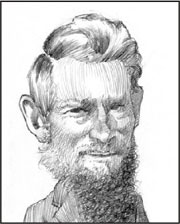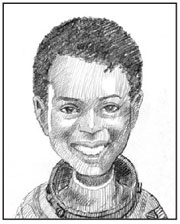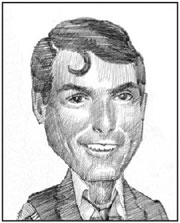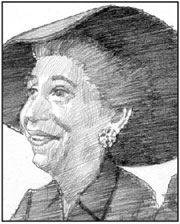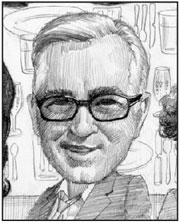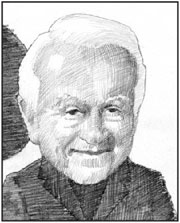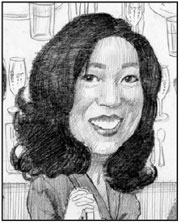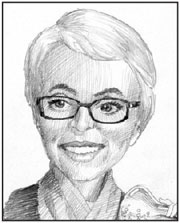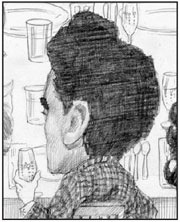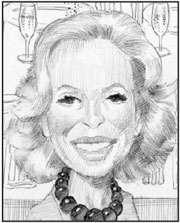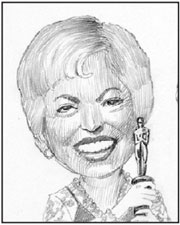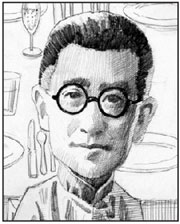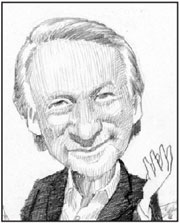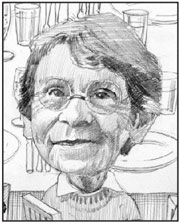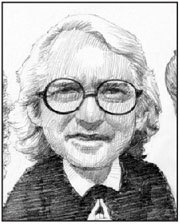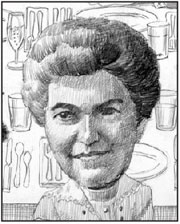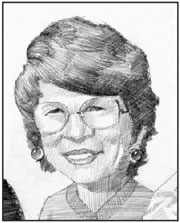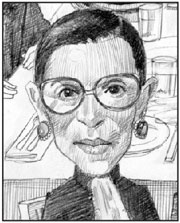For your optimal viewing experience, subscribe to CAM in print.
Your second-best option: when the document finishes loading, click on the “[ ]” in the toolbar to initiate full-screen viewing of this once-in-a-sesquicentennial spread.
Read the article online.
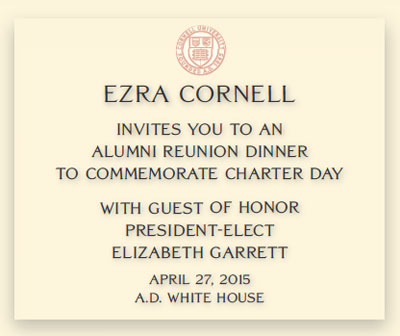 To commemorate Charter Day, we imagined an alumni reunion dinner (unfettered by the constraints of time) that proud founder Ezra Cornell might host to introduce president-elect Elizabeth Garrett to his namesake institution. Spanning decades and disciplines, our invitees include Nobelists, Oscar- and Pulitzer-winners; artists and scientists; authors and entertainers; activists and lawyers; politicians and pundits. Some are happy in the limelight, others are more reticent.
To commemorate Charter Day, we imagined an alumni reunion dinner (unfettered by the constraints of time) that proud founder Ezra Cornell might host to introduce president-elect Elizabeth Garrett to his namesake institution. Spanning decades and disciplines, our invitees include Nobelists, Oscar- and Pulitzer-winners; artists and scientists; authors and entertainers; activists and lawyers; politicians and pundits. Some are happy in the limelight, others are more reticent.
Of course, a dinner table—even an extended one—couldn’t possibly have enough seats to represent the extraordinary diversity of all those who’ve studied on the Hill over the past fifteen decades. Nevertheless, we feel sure that in this company our guest of honor will enjoy a lively and entertaining evening of discussion, debate, and discovery (Illustration by William Benson ’72).

Around the table
Although our guest list comprises accomplished alumni from a dizzying variety of fields, any such collection of invitees is inherently subjective. If you could add another leaf to our table, whom would you include? Leave a note in the comments.
|
Ezra Cornell – University founder and namesake Carpenter, mechanic, farmer, salesman, inventor, entrepreneur, politician, and philanthropist, Ezra Cornell was an extraordinary man. While he referred to himself simply as a farmer and mechanic who had spent some time working in the telegraph industry, through skillful work, uncommon tenacity, and fortuitous circumstances he amassed a fortune. Cornell envisioned America as a place where technology, wealth, and altruism could come together to benefit all the inhabitants. As soon as it became clear that he had a fortune, he used those riches to found a unique university. From: “The Ezra Cornell Bicentennial Exhibition,” Cornell University Library RMC |
Elizabeth Garrett – president-elect An undergraduate alumna of the University of Oklahoma—where she earned a BA in history with special distinction—incoming University President Elizabeth Garrett has a JD from the University of Virginia. Garrett becomes the thirteenth – and first female – president of the University in July 2015. More at: “Meet the President,” November/December 2014 |
|
Mae Jemison, MD ’81 – physician and first African American woman astronaut |
Svante Myrick ’09 – youngest ever (and first African American) mayor of Ithaca Ask Svante Myrick if he’s sick of being asked about his two mayoral firsts—he’s not only the youngest in Ithaca history, but the first African American—and he’ll tell you a story. It’s one he heard from a staff member whose sixteen-year-old son dropped by City Hall. “He’s a young black man, and in the elevator someone asked him, ‘Are you the mayor?'” Myrick recalls. “She told me this, and I laughed. And she said, ‘No, you don’t understand. He’s been mistaken for a lot of things. He’s been stereotyped; people have crossed the street when they saw him coming. But to have somebody assume that he’s an authority figure—that he should be respected rather than feared—had never happened before.'” More at: “Mr. Mayor,” September/October 2012 |
|
Christopher Reeve ’74 – actor (Superman) and medical activist Christopher Reeve became an instant star with the 1978 release of Superman, and went on to appear in three sequels as well as such films as Deathtrap and The Remains of the Day. Following a riding accident in 1995 that left him paralyzed, Reeve became a tireless advocate for the disabled and spinal cord research. More at: “A Brave Face,” July/August 1998 (PDF) |
Margaret Bourke-White ’27 – first female photojournalist at Life magazine Margaret Bourke-White was one of the first four staff photographers for Life magazine, the first American female war photojournalist, and a pioneer in the field of social photojournalism. During her career, she photographed the Dust Bowl, World War II, the siege of Moscow, concentration camps, Mohandas Gandhi, the Korean War, and more. Bourke-White succumbed to Parkinson’s disease in 1971. |
|
Pearl S. Buck, MA ’25 – Pulitzer and Nobel-winning author (The Good Earth), humanitarian activist Pearl S. Buck was the first American woman to win a Nobel Prize in literature. Buck’s second novel, The Good Earth, won the Pulitzer Prize in 1935. Buck was also active in the civil rights movement, and promoted the idea of cross-cultural tolerance and understanding. |
Keith Olbermann ’79 – sports journalist and political commentator ESPN and MSNBC As a sportscaster for Ithaca’s WVBR, the student-run FM radio station, a teenage Keith Olbermann was prone to irreverence. On pleasant days he’d haul his microphone outside the station’s Linden Avenue headquarters and broadcast in the sunshine. Once he did the sports in rhyme. He’d been reading a lot of Ring Lardner and was inspired to compose a two-and-a-half minute sportscast in verse, just as the legendary newspaperman had done as a beat reporter covering a Cubs-Giants rainout in 1910. After wrapping the bit, Olbermann walked into the control room, where he found the station engineer getting off the phone. “Somebody just called in,” the engineer announced, “and asked me, ‘Is this guy a jackass, or what?'” More at: “Smart Bomb,” March/April 2007 |
|
Robert Atkins, MD ’55 – inventor of the Atkins Diet, scourge of bread lovers Dr. Robert Atkins, physician and cardiologist, is most well known for the Atkins Diet, a controversial program he developed that promotes controlled carbohydrate nutrition. |
Michelle Rhee ’92 – controversial education reformer, former D.C. schools chancellor Michelle Rhee catapulted to national prominence as a result of her tumultuous three years as schools chancellor in the District of Columbia. Appointed in 2007 by Mayor Adrian Fenty to overhaul the troubled D.C. system, she fired hundreds of teachers and principals, closed schools, and reorganized the bureaucracy. Test scores rose and enrollment stabilized, but her steamroller style made enemies. She has since started a new organization, Students First, to promote school reform. More at: “Pop Quiz,” March/April 2011 |
|
Gabby Giffords, MRP ’97 – former U.S. Representative, advocate for gun control Gabby Giffords was the youngest woman ever elected to the Arizona Senate when she won her first term in 2002. As state senator for the 28th district, which covers the Tucson neighborhoods bordering the University of Arizona campus, she represented college professors and blue-collar families, Anglos and Latinos, Democrats and Republicans. In 2011, Giffords survived an assassination attempt, and retired from her congressional seat in 2012. She and her husband now run the political action committee Americans for Responsible Solutions. More at: “Praising Arizona,” January/February 2005. |
Thomas Pynchon ’59 – novelist (Gravity’s Rainbow, The crying of Lot 49) famed for his reclusiveness A notoriously reclusive writer, Thomas Pynchon wrote V, Gravity’s Rainbow, and, most recently, Bleeding Edge. His book awards include the MacArthur Fellowship and the National Book Award for Fiction (Gravity’s Rainbow). Inherent Vice, directed by Paul Thomas Anderson, is the first film adaptation of a Pynchon novel. |
|
Bill Nye ’77 – TV educator known as “The Science Guy” Bill Nye combines comedy, science, and his singular charisma to educate the public about complex (and not-so-complex) science topics. He hosted the Disney/PBS show Bill Nye the Science Guy from 1993-1998. Nye holds several US patents and has collaborated on several scientific projects including a sundial (dubbed MarsDial) carried by the Mars Rover. |
Dr. Joyce Brothers ’47 – psychologist and TV personality Dr. Joyce Brothers double-majored in home economics and psychology while at Cornell. In 1958 she hosted a television advice show revolving around relationships, becoming the first television psychologist. Dubbed the “mother of media psychology,” Brothers enjoyed a five-decade career in television. |
|
Thelma Schoonmaker ’61 – three-time Oscar-winning film editor (Raging Bull, The Departed, The Aviator) Thelma Schoonmaker is a film editor noted for her decades-long partnership with director Martin Scorcese. Schoonmaker spent years fighting for admission into the male-dominated Motion Picture Editor’s Guild. She has garnered dozens of nominations and awards, including Oscars, Emmys, and BAFTAs. |
Hu Shih 1914 – modernizer of the Chinese alphabet, diplomat Hu Shih may be the most famous Cornell alumnus Americans have never heard of. He came to Cornell on a Boxer Indemnity Scholarship, a program (funded by compensation money paid after the rebellion) that introduced many young Chinese scholars to Western ideas, creating an elite group that would effect sweeping changes in their homeland. After earning a PhD in philosophy from Columbia, he returned to China and became determined to modernize its language and literature. While at Peking University, he oversaw the translation of classical Chinese works into common speech, a radical undertaking that eventually led to the government’s adoption of the vernacular as the national language. More at “Renaissance Man,” July/August 2014 |
|
Bill Maher ’78 – comedian and political commentator, host of “Real Time with Bill Maher“ Bill Maher has had politicians in his sights and audiences in stitches for three decades. Whereas once his career could have been characterized as stand-up comedy infused with political observation, it has morphed into unflinching political satire. Maher aims for hilarity by exploring what he considers to be hypocrisy, duplicity, and imbecility; he’s so fearless, it’s funny. More at: “Laugh Riot,” July/August 2012 |
Barbara McClintock ’23, PhD ’27 – Nobel-winning geneticist Barbara McClintock enjoyed a long and distinguished career in cytology and genetics research, where her thinking was, in the words of Professor Mark Sorrells, “clearly decades ahead of her time.” In 1983 she was awarded an unshared Nobel Prize in Physiology or Medicine for her discovery of “mobile genetic elements.” More at “Bit by Bit,” March/April 2014 |
|
Toni Morrison, MA ’55 – Pulitzer and Nobel-winning author (Beloved) Toni Morrison has garnered many prestigious literary awards including the National Book Critics Circle Award, the Pulitzer Prize for fiction, the American Book Award, the Jefferson Lecture, the National Medal of Distinguished Contribution to American Letters, and the Nobel Prize in Literature. Her first novel (The Bluest Eye) debuted in 1970. Her latest (God Help the Child) is slated for publication in April of 2105. |
Peter Yarrow ’59 – folk singer (Peter, Paul and Mary) Peter Yarrow catapulted to fame with the musical group Peter, Paul and Mary. Yarrow wrote some of the trio’s most famous songs, including “Puff the Magic Dragon,” “Day is Done,” and “The Great Mandella.” He founded the New Folks Concert Series and is deeply involved in social activism. In 2000 he founded Operation Respect, a non-profit organization aimed at combating bullying and school violence. |
|
Richard Meier ’56, BArch ’57– superstar architect (Los Angeles’ Getty Center), winner of the Pritzker Prize, the field’s highest honor Best known for high-profile projects such as the Getty Center in Los Angeles, the Manhattan-based architect has won just about every prize in his field including the Pritzker, architecture’s highest honor. Some of his best-known works include the High Museum of Art in Atlanta, Jubilee Church in Rome, the Atheneum in New Harmony, Indiana, the Arp Museum in Germany, and the Perry Street condominiums in Manhattan. In addition to Weill Hall, the Cornell life sciences building that opened in 2008, Meier designed two projects for the Ithaca campus that were never realized: an alumni and admission center overlooking Fall Creek and a serpentine student housing complex for North Campus. More at: “Small World,” January/February 2015 |
Martha Van Rensselaer 1909 – home economics pioneer, one of the first two women to be full professors at Cornell Co-founder of the College of Human Ecology, Martha Van Rensselaer was regarded as a leading authority on issues affecting women and families. She played a prominent national role in setting social policy that affected families and children. As a result of her significant national contributions, in 1923 the League of Women Voters recognized her as one of the twelve most important women in America. |
|
Janet Reno ’60 – first woman to serve as Attorney General Janet Reno became the first woman to serve as US Attorney General in 1993. After running for political office, Reno now tours the country speaking about the criminal justice system. She also serves on the board of directors for the Innocence Project, an organization dedicated to exonerating wrongly convicted individuals through DNA testing. |
Kurt Vonnegut ’44 – novelist (Slaughterhouse-Five, Cat’s Cradle), chronicler of the horrors of war Kurt Vonnegut was both an author and an artist. His prose most frequently used science fiction as a medium (Cat’s Cradle), and his felt-tip art reflected postmodern styles (One-Eyed Jack). He spent part of World War II as a prisoner of war; that experience, coupled with the bombing of Dresden, informed his most well known work, Slaughterhouse-Five. |
|
E. B. White ’21 – essayist and author (Charlotte’s Web, Stuart Little) Many modern readers know E.B. White for his classic children’s novels Charlotte’s Web, Stuart Little, and The Trumpet of the Swan. But his literary legacy owes as much to his prolific career as a New Yorker essayist during his years in the city and, later, in rural Maine, where his family still resides. “I would really rather feel bad in Maine,” he wrote in a 1937 letter, “than feel good anywhere else.” More at: “Parts of Speech,” January/February 2012 |
Ruth Bader Ginsburg ’54 – Supreme Court justice, pioneering litigator for women’s rights Ruth Bader Ginsburg has emerged as the leader of the court’s liberal wing, having voted in favor of such issues as affirmative action, marriage equality, campaign finance limits, gun control, and abortion rights. Among her proudest achievements, she says, is United States v. Virginia (1996), in which she wrote the majority opinion in the 7-1 decision that ended the exclusion of women from the Virginia Military Institute. In Ledbetter v. Goodyear Tire & Rubber Co. (2007), she wrote a strong dissent that ultimately prompted Congress to pass a law making it easier for workers to win claims of salary discrimination on the basis of gender. More at: “Justice Prevails,” November/December 2013 |



